16th Century
Russia during the 16th Century is dominated by one figure: Ivan the Terrible, who has gone down in history as one of the most infamous leaders of all times. His long reign, firstly as grand prince and then as the first tsar, witnessed Russia conquer the Kazan and Astrakhan Khanates and expand its borders into Siberia but this coincided with a long and costly war in Livonia, raids at the hands of the Crimean Tatars and the madness and violence of the Oprichnina as Ivan lost his mind. His legacy even threatened the destruction of the state itself and led to the eventual downfall of the House of Ryurik.
The Last years of Ivan the Great
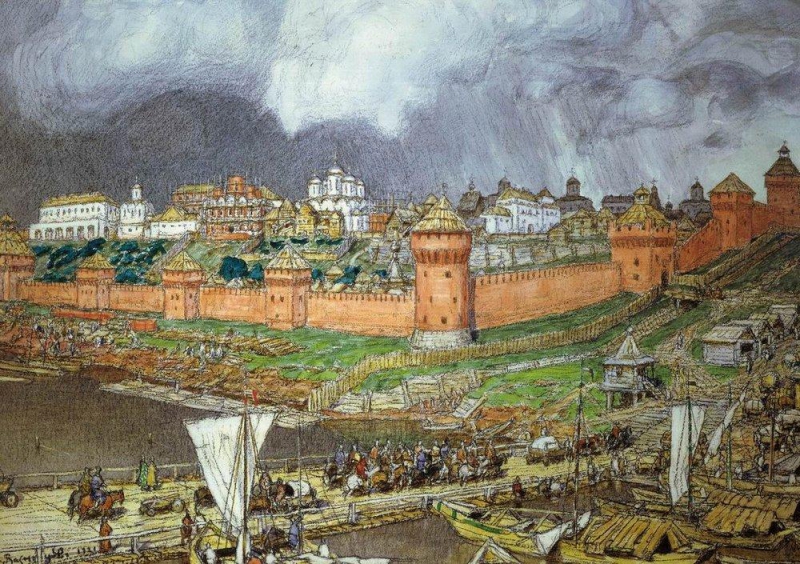
In 1500 rumours reached Ivan III that his daughter Yelena - the wife of Grand Duke Aleksandras of Lithuania - was being mistreated and forced into renouncing her Orthodox faith in violation of the marriage treaty. Using this as a pretext, war broke out between Moscow and Lithuania which ended with a peace treaty where one-third of Lithuanian territory, including the old Kievan-Rus city of Chernigov, was ceded to Moscow, although Ivan III's aim of recapturing Smolensk was not achieved. In the last years of Ivan III's reign a struggle to be named heir broke out between his grandson Dmitry Ivanovich (the son of Ivan III's oldest son Ivan Ivanovich who died in 1490) and Ivan III's oldest surviving son Vasily Ivanovich. In 1498 it seems that Dmitry Ivanovich had taken the advantage upon being named co-ruler, however he allowed himself to get involved in various conspiracies which led to his eventual arrest and imprisonment. Ivan III died in 1505 and was succeeded by Vasily Ivanovich (Vasily III) who inherited a large territory ruled from Moscow which laid claims to being the successor of the Byzantine Empire. Dmitry Ivanovich on the other hand ended his days in 1509 still in prison.
Reign of Vasily III
Vasily III continued the policies of his father in gathering Rus lands. In 1510 he marched on the Pskov Republic and declared the dissolution of the Pskov veche and the annexation of the republic into Moscow. In 1513 Prince Fyodor Borisovich of Volokolamsk died and Vasily III in turn annexed his cousin's territory. In 1513 Vasily III led Muscovite troops in besieging Smolensk which had been lost to Lithuania in 1404. The city was eventually recaptured on a third attempt in 1514. In 1520 Vasily III invited Grand Prince Ivan Ivanovich of Ryazan to Moscow where he had him arrested due to the relation Ryazan had with the khan of Crimea. When Ivan Ivanovich escaped from prison to Lithuania in 1521 Vasily III used it as a pretext to annex his principality.
The Long-Awaited Heir
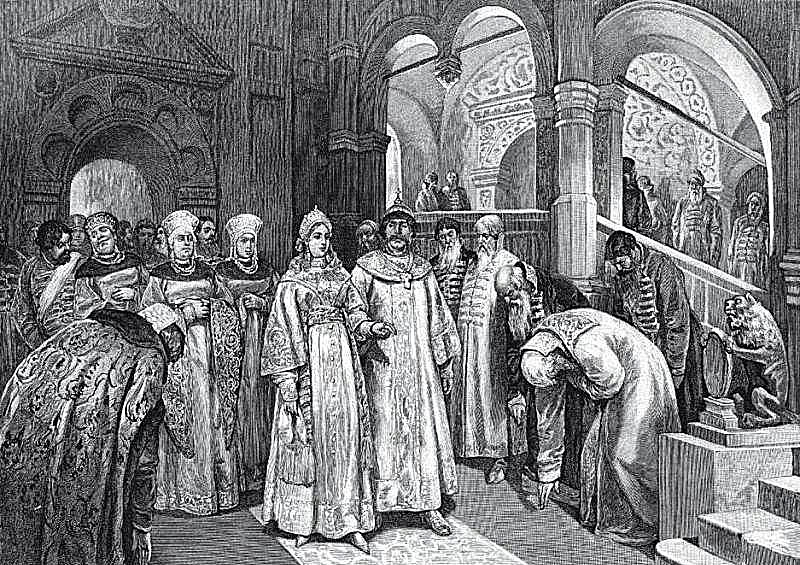
Vasily proved to be a rather successful grand prince in terms of widening Moscow's influence and borders but in one sphere he proved less successful - after 20 years of marriage he still had no heir. Despite protests from the Church, in 1526 Vasily decided to divorce his wife Solomonia Saburova by exiling her to a convent in Suzdal and to remarry. Yelena Glinskaya became his new wife and she gave Vasily his long-awaited heir in 1530 plus a spare in 1532. In Russian folklore the Salomnia cursed Vasily and his new wife. In any case, Vasily's heir would grow up to be the infamous Ivan the Terrible. Vasily died shortly after the birth of his sons in 1533.
Regency of Yelena Glinskaya
When Ivan the Terrible was just a child his mother, Yelena Glinskaya, reigned as regent. Glinskaya was fully aware of the delicate position she and her infant children were in. She considered her major threat to be her brothers-in-law who could easily become involved in a plot by boyars in a play for power. In 1534 she had Prince Yuri Ivanovich of Dmitrov arrested and seized his land in the name of her son. Yuri Ivanovich died in prison in 1536. In 1537 rumours reached Yelena that the next eldest brother Prince Andrey Ivanovich of Staritsa was attempting to flee to Lithuania. Yelena had him arrested and he too ended his days in prison - his territory passing to his baby son Vladimir who was bought to Moscow. Even seeing off two potential threats was not enough though, as Yelena herself was dead by 1538, most likely poisoned by a boyar - the main suspects being the Shuisky family.
Coronation of Tsar Ivan the Terrible

The orphaned Ivan and his deaf-mute brother Yury were left to the mercy of the boyars who probably had a role in the death of their mother. Ivan later complained how he and his brother were neglected by the boyars who were too busy fighting among themselves to secure influence to actually play a useful role in concerning themselves with the health and upbringing of the young grand prince. This resulted in Ivan developing a deep hatred for the boyars in later years. In 1547 Ivan finally reached maturity and no longer needed a regent. In a clear show of him now taking up the reins he planned his coronation where he was named not just grand prince of Moscow but tsar of Russia - the first to be officially crowned as such. The word tsar is a corruption of the name Caesar and was traditional used by the Russians to refer to the Byzantine emperor or the khan of the Golden Horde. At his coronation Ivan declared that he was now the sole and supreme leader of Russia.
Reforms
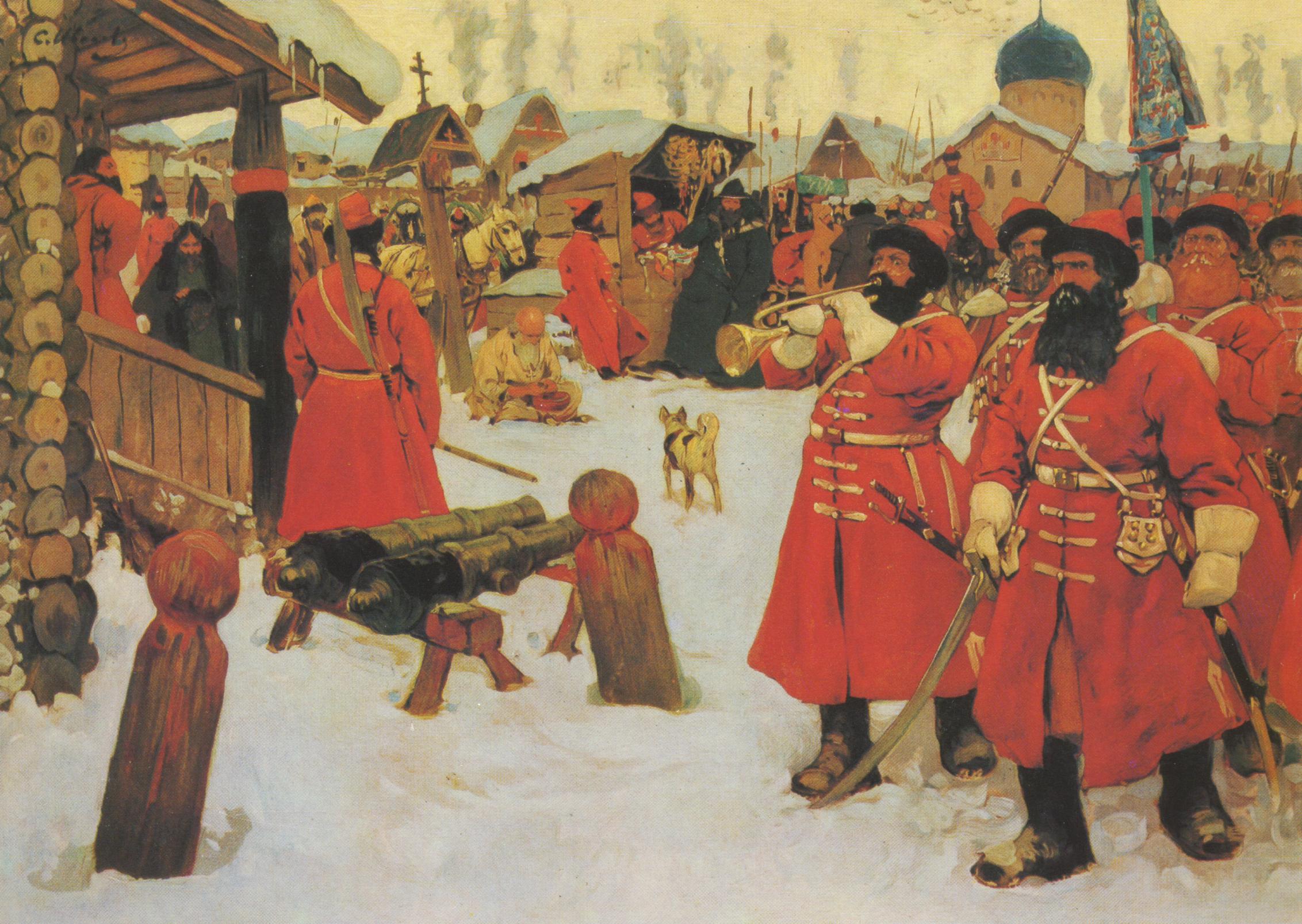
The first year of Ivan's reign was met with disaster in the form of the Great Fire of Moscow in the summer of 1547. At this time most of the city was built out of wood and one-third of the city went up in flames, claiming the lives of thousands of people and setting off a rebellion which saw the Glinsky family fall from grace. Once this difficult period was over Ivan was able to put his authority to good effect and began a series of reforms. He introduced a new code of laws which in part put greater restrictions on the movement of peasants, established a standing army known as the Streltsy and a form of parliament known as the Zemsky Sobor. In 1551 Muscovy Company was founded in England which saw trade flourish between Russia and England via Arkhangelsk and the White Sea and in 1553 the first printing press was opened in Moscow.
Origins of the Cossacks
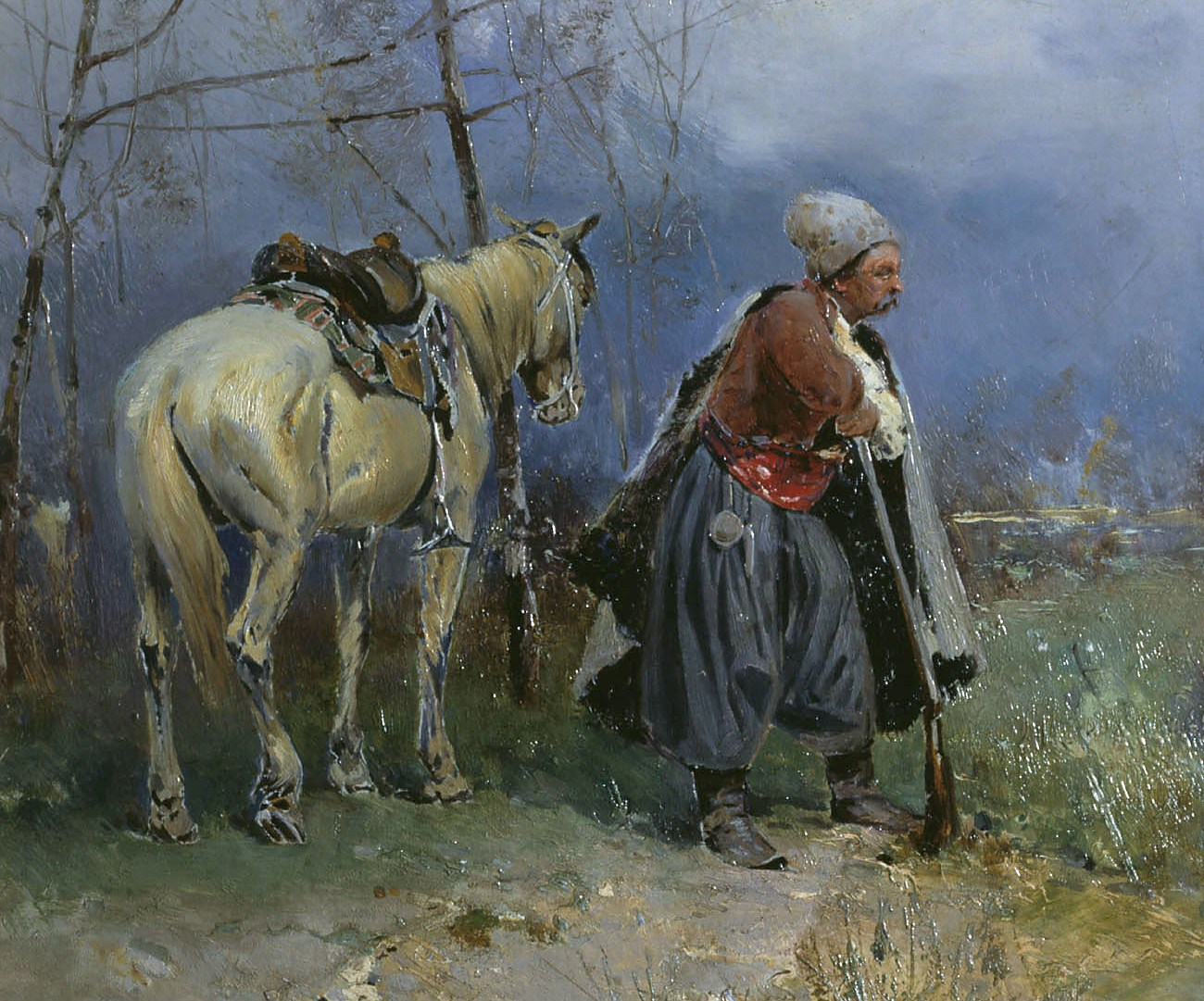
For centuries Slavic people had been settling in the steppe area around the lower reaches of the River Don, Dnieper and Ural and assimilating with other steppe people such as the Khazars, Pechenegs, Polovsty and Tatars. By the 15th century these people had become known as Cossacks and were living in communities independent from their neighbours of Poland-Lithuania, Moscow and the Crimean Khanate. By the 16th century independent territorial organisations, known as hosts, had come into existence. The major hosts included those of the Zaporozhian Cossacks (located around the Dnieper in what is now Ukraine), the Don Cossacks (around the River Don) and the Yaik/Ural Cossacks (around the River Yaik which was later renamed the River Ural). Several other smaller hosts would also later be formed. The Cossacks organised themselves on military lines and were excellent horsemen, making them in demand by neighbouring Poland-Lithuania and Russia in providing military assistance in defending borders from Tatars or in joining campaigns. Ivan the Terrible, for example, clearly understood the value of the Cossacks when he set his eyes of the khanates of Kazan, Astrakhan and Siberia.
Conquest of the Kazan and Astrakhan Khanates

Ivan's administrative reforms on the whole proved successful but Ivan's rule reached its peak in 1552 when he succeeded where his father and grandfather failed - conquering the Kazan Khanate after decades of war between Moscow and Kazan. This success led to the neighbouring Bashkirs accepting Ivan's authority in 1554 and the annexation of the Astrakhan Khanate by Russian in 1556. The end of the Tatar-Mongol Yoke officially ended during the reign of Ivan's grandfather Ivan the Great, but it was really Ivan the Terrible who saw this arrangement put into practice by absorbing much of the remnants of the Golden Horde into the now multi-ethnic and multi-faith Tsardom of Russia - only the Crimean Khanate remained as a major threat. In celebration of the conquest of Kazan, Ivan ordered the building of St Basil's Cathedral on Moscow's Red Square - allegedly inspired by the main mosque which once stood in Kazan.
Outbreak of the Livonian War
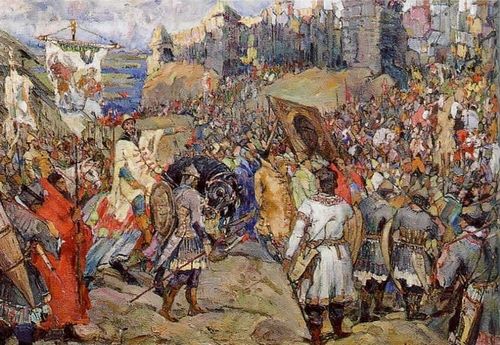
After the successes over the Tatars, Ivan turned his attention to gaining access to the sea by taking advantage of the weakened position of the Livonian Confederation (modern-day Latvia and Estonia). In 1558 Ivan ordered the invasion of Livonia on the pretext of Livonia entering into an alliance with Poland-Lithuania in violation of an earlier treaty between Livonia and Russia. The Russians quickly made gains by capturing Dorpat and Narva and besieging Revel. In 1561 the Livonian Confederation was disbanded and the former territory passed to Lithuania. This led to war between Russia and Lithuania. Eventually Sweden and Denmark also entered the bloody struggle for Livonia which would last decades and become a massive drain on Russia.
The Oprichnina
After the Conquest of Kazan it might have seen as if the first tsar was on a course to match and even exceed the successes of his grandfather Ivan the Great, but instead in the 1560s Ivan the Terrible earned his famous English sobriquet of Terrible (in Russian he is known as 'Ivan Grozny' which can be translated as 'formidable' or 'awesome'). In 1560 Ivan's wife Anastasia Romanovna Zakharina-Yurieva died and it was another case of suspected poisoning. This was followed in 1564 by Prince Andrey Kurbsky - one of Ivan's most trusted friends - defecting to the Lithuanians. All this seems to have had a drastic effect on Ivan's mental health, which since his traumatic childhood was always fragile. Ivan's suspicion and hatred of the nobility boiled over and in December 1564 he went to Aleksandrova Sloboda and announced his abdication due to the corruption and treason of the boyars. The boyars in turned feared for their safety and positions at the hands of the citizens and begged Ivan to return.
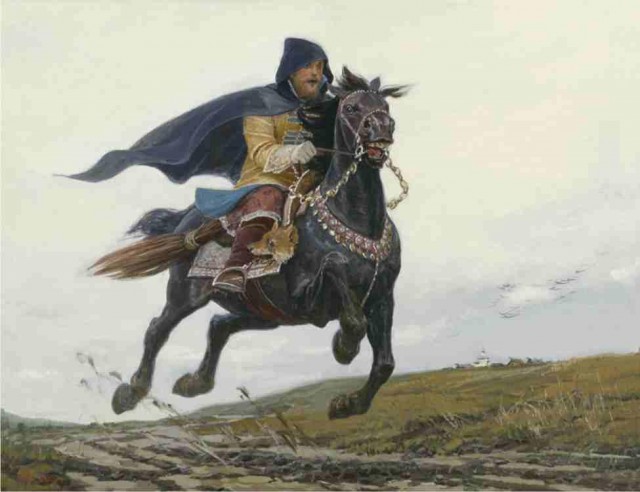
Ivan agreed but only on the condition of the establishment of the Oprichnina - a state within a state, mainly incorporating the old Novgorod Republic, where Ivan would have free reign. Ivan established a guard known as the oprichniki who were mainly made up of lower ranks of people who therefore were extremely loyal to Ivan in thanks for their elevation in status. The oprichniki were set up in a manner similar to a monastic order and had as their base Aleksandrova Sloboda. They rode on horseback bearing the insignia of a broom and a dog's head and terrorised the civilian populations and eliminated all who stood in their way with full immunity.
The Murder of Metropolitan Phillipp
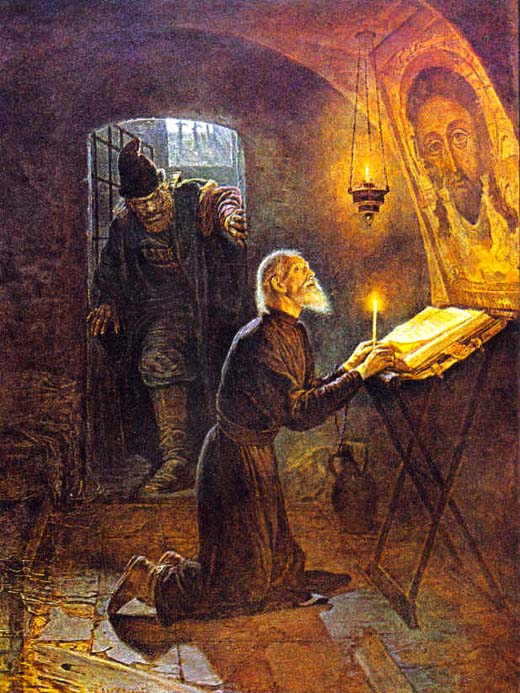
In 1568 Metropolitan Phillipp bravely refused in public to bless Ivan in response to the atrocities which were being committed by the oprichniki. Unsurprisingly this led to him being disposed, arrested and eventually murdered by the oprichnik Malyuta Skuratov in 1569 in Tver.
Prince Vladimir of Staritsa
In 1553 Ivan the Terrible fell gravely ill. He felt his end was near and ordered his boyars to swear fealty to his baby son. However most boyars instead favoured the candidate of the tsars cousin Prince Vladimir Andreevich of Staritsa, who was raised in Moscow after his father's downfall but since 1542 had been living in Staritsa. To the dismay of many boyars Ivan recovered and now was extremely suspicious of his cousin and had him brought back to Moscow where he could be supervised and groomed to become the regent for Ivan's children son should anything happen to him. Ivan though could not overcome his suspicions and in 1569 he charged Vladimir with treason and Vladimir and his family were forced to drink poison at Aleksandrova Sloboda, while Vladimir's mother was drowned outside the Goritsky Convent where she had previously been forced to take the veil.
The Massacre of Novgorod
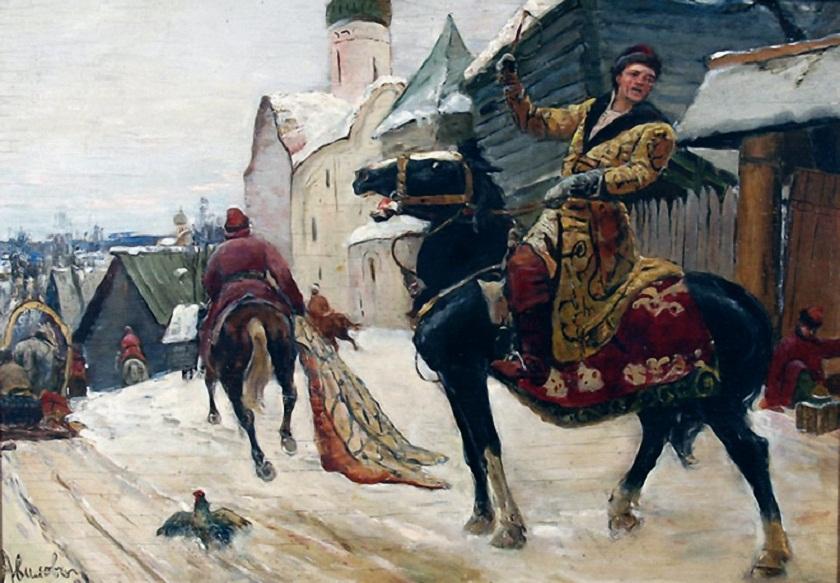
The zenith of the madness and cruelty of Ivan manifested itself in the Massacre of Novgorod. In 1569 the city of Izborsk fell to the Lithuanians after an act of treason and, although it was quickly recaptured, Ivan became paranoid that leaders of many northern cities, including Novgorod and Pskov, were all potential traitors. Ivan saw no alternative than to act first and march on the potential traitors. Ivan himself lead his oprichniki from Aleksandrov - the capital of the Oprichnina. Their first point of call was Klin which they plundered before reaching Novgorod in January 1570. Ivan was met by Archbishop Pimen and the clergy as tradition dictated, but Ivan proceeded to accuse them of treachery before ordering that service should be held. The service was followed by a banquet after which the oprichniki were unleashed bringing devastation to the city, sparing not even the city's ancient St Sophia Cathedral and its monasteries. Trials saw thousands tortured and executed, mainly members of the nobility, the clergy and merchant class. Many were thrown alive and bound under the ice of the frozen River Volkhov and were stabbed should they fail to drown or freeze to death. Archbishop Pimen of Novgorod was stripped of his rank and in fact his clothes and paraded around the city on a white mare followed by dancing minstrels known in Russian as skomorokhi. He too eventually died in prison in 1571. The lower classes who were largely not targeted by the massacre itself were not spared the ensuing famine brought on by the devastation.
The Campaign against Pskov
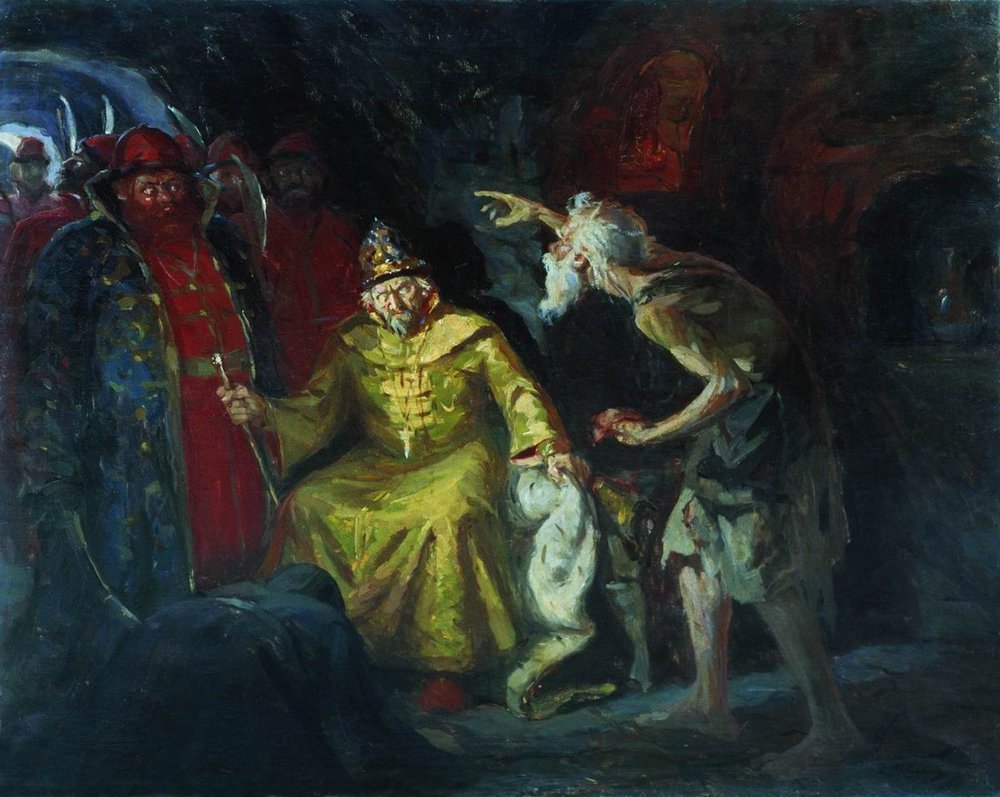
In February 1570 the oprichniki left Novgorod for Pskov, which by now was fully aware of what to expect. Several members of the clergy and nobility were murdered but the atrocity of Novgorod was not repeated in Pskov. The city's salvation is credited to a 'fool of God' called Nikola Salos who offered the tsar a lump of uncooked meat saying that it should not displease a man who eats the flesh of men and went on to predict horrors in store for Ivan should he continue with his massacre of Pskov. Unnerved, Ivan ordered his men to leave the city. Subsequent trials, tortures and executions however followed in Moscow.
Invasion of the Crimean Tatars
While the oprichniki were busy tormenting supposed internal enemies of Russia, the country's actual external enemies in the form of Lithuania and Crimea were making good use of Russia's weakness. In May 1571 Khan Devlet I Geray of Crimea lead a strong Tatar army against Moscow. It bypassed the defences of Serpukhov without problem and quickly reached Moscow where civilians of the surrounding areas had fled. The Tatars ravaged the surrounding areas and set the whole area alight. The flames eventually engulfed the capital. Crowds sought shelter in the few stone churches that existed which would eventually collapse during the intensity of the fire or the pressure of the crowds. People sheltering in cellars suffocated and many who jumped into the river to escape drowned. In all it is said to have taken over a year to clear all bodies. Content with their pillaging the Tatars retreated back to Crimea.
The tragedy of the Fire of Moscow in 1571 it believed to have helped shake Ivan from his madness and realise how his actions had brought Russia to its knees and at the mercy of the Crimean Tatars. In 1572 the Oprichnina was reunited with the rest of Russia (known as the Zemschina) and Russian troops were able to defend Moscow from the subsequent Crimean Tatar invasion of 1572 at the Battle of Molodi.
End of the Livonia War
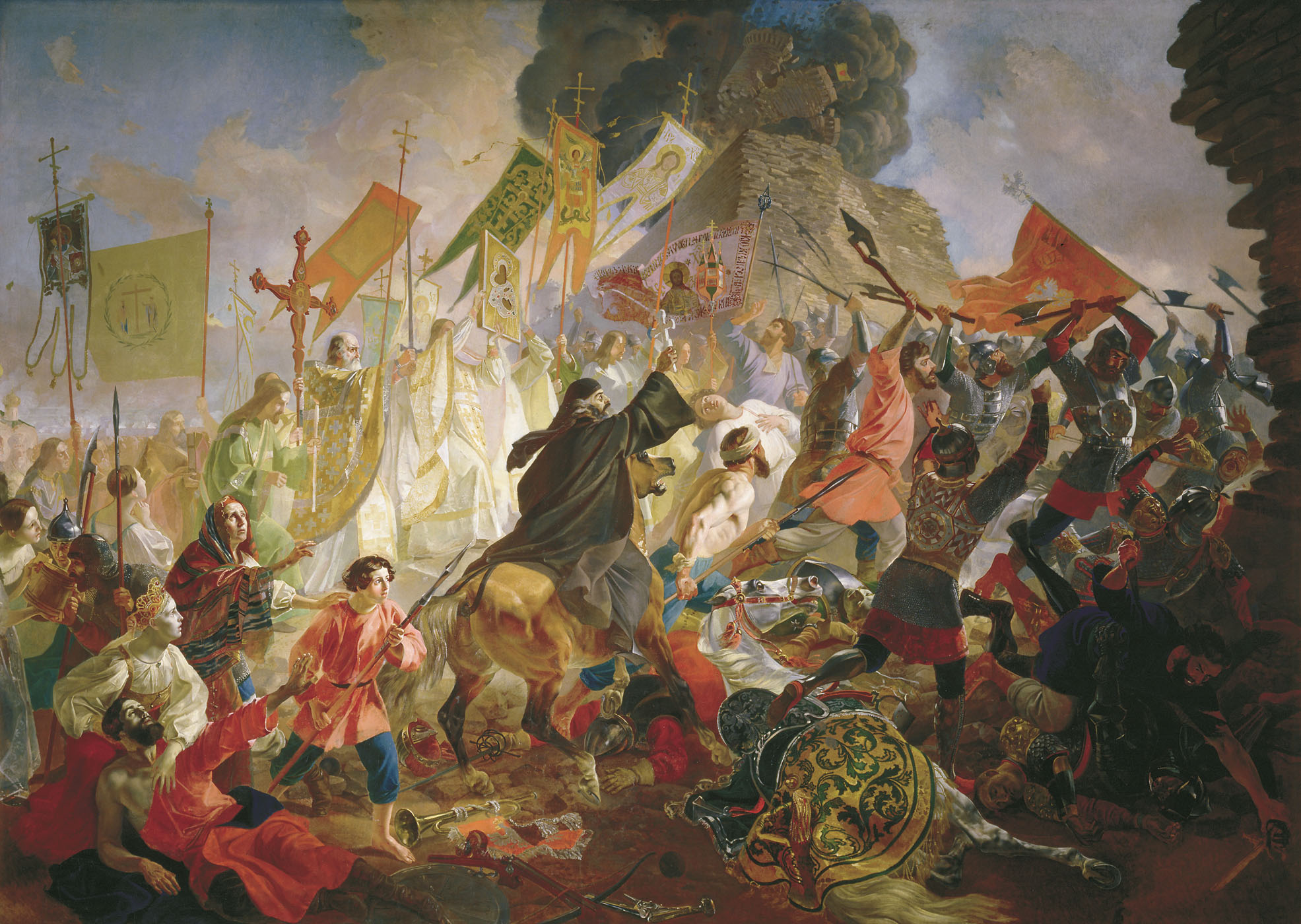
In 1577 the new king of Poland-Lithuania Stefan Batory brought new energy to the Livonian war after allying himself with King Jan II of Sweden. Russia was forced to retreat from Livonia and found itself on the defence in Russia itself. The Polish captured the city of Polotsk in 1579 and then Velikie Luki in 1580 and began besieging Pskov in 1581. Meanwhile the Swedish managed to capture Korela and Narva in 1580 and then Ivangorod, Yam and Koporye in 1581. Russia was forced to seek a truce which was obtained with Poland-Lithuania in 1582 and with Sweden in 1583. Both treaties required Russia to cede the land it had lost.
Conquest of the Siberia Khanate

Despite the chaos back in the heartland of Russia, in 1580 a new campaign began which would to push Russia's borders even further east as a group of Cossacks lead by Yermak Timofeevich set off on a campaign to conquer the Siberian Khanate of Khan Kuchum. The campaign was funded by the Stroganov family who saw an opportunity to develop their already successful trade enterprise. In 1582 the Siberian capital of Qashliq (near to modern day Tobolsk) was captured by Yermak's troops, but Kuchum's horde was able to escape and attacked the Cossacks in 1584, killing Yermak in the process. The remaining Cossacks then razed Qashliq to the ground and established a new fortress in Tyumen in 1586 and then in Tobolsk in 1587. Khan Kuchum was eventually defeated in 1598. The khan managed to escape once more, but his sons were captured and taken to Moscow, where they eventually became part of the Russian nobility. His khanate was conquered by the Russians. Kuchum eventually died in exile sometime in the beginning of the 17th century.
Final Years of Ivan the Terrible
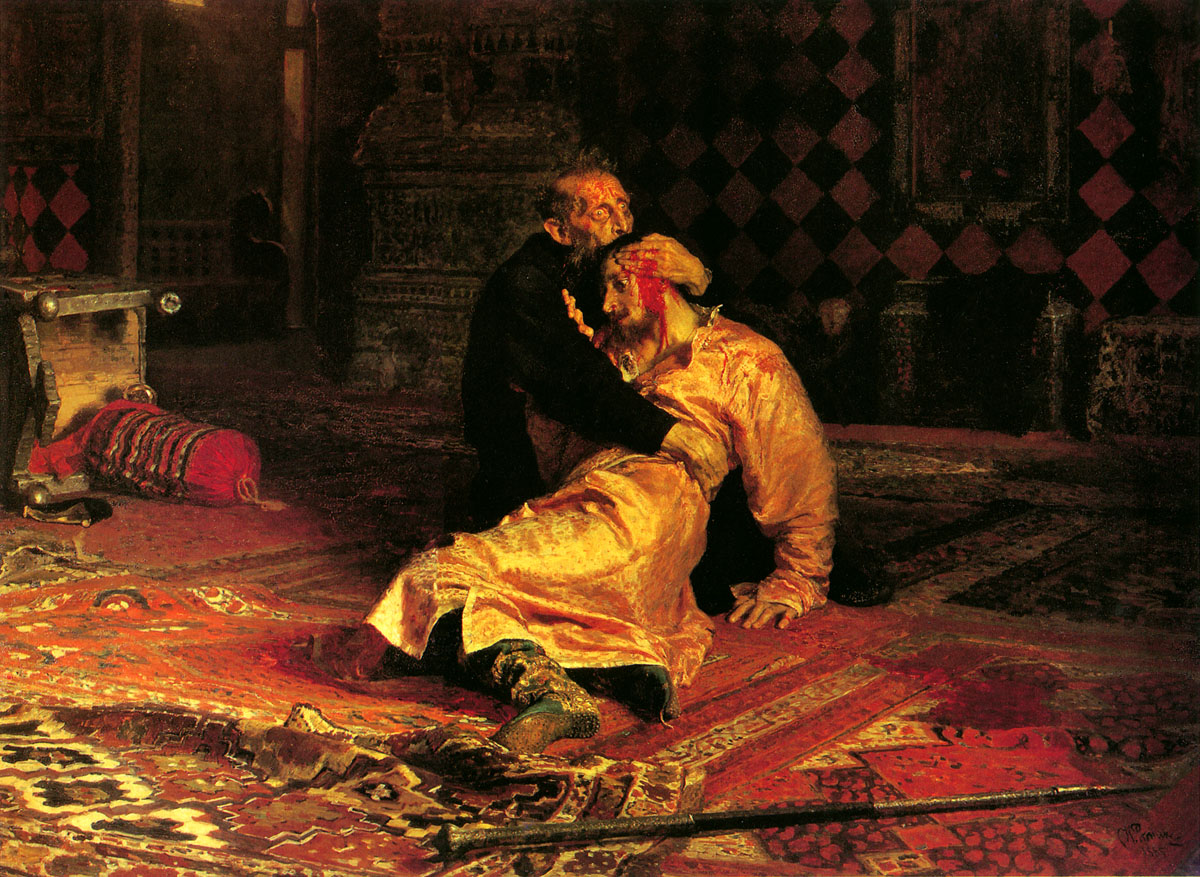
By the end of the 1570s the horror of the Oprichnina years were largely over and Ivan even attempted to make amends with donations to monasteries to repent for the sins and pray for his victims. Yet one more famous act of madness came in 1581. An argument broke out between Ivan and his eldest surviving son Tsarevich Ivan Ivanovich, perhaps about the immodesty of the dress worn by Ivan Ivanovich's wife. During the heated exchange Ivan is said to have struck his son on the head with his staff, killing him in the process.
Ivan the Terrible died in 1589, allegedly while playing chess. Ivan had been married seven times (which was against Church law) but only had two more heirs after the death of Ivan Ivanovich - the mentally disabled Fyodor Ivanovich, who succeeded Ivan as Feodor I, and the infant Dmitry Ivanovich.
Feodor I and the Regency of Boris Godunov
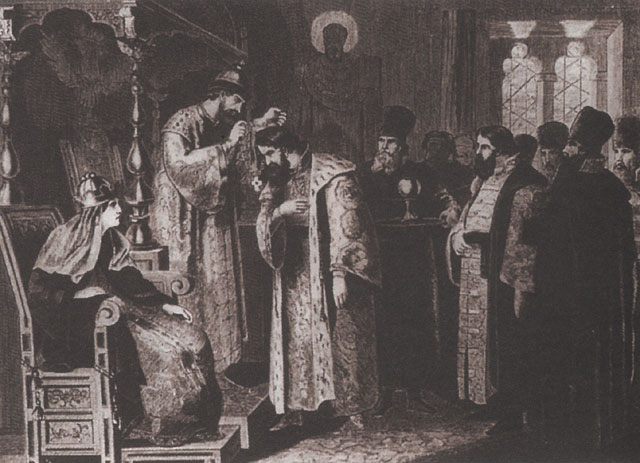
Before his death Ivan the Terrible appointed a regency council to advise his son knowing that his feeble-minded son was too weak to rule by himself. The council consisted of Fyodor I’s uncle Nikita Romanovich Zakharin-Yuriev - the brother of Ivan’s beloved first wife - and oprichnik-turned-boyar Boris Godunov whose sister Irina married Fyodor I in 1575. Nikita Romanovich Zakharin-Yuriev died in 1586 leaving Boris as the sole regent and in fact he ruled Russia in Feodor’s name who preferred to spent his time in worshop. Boris proved to be a rather effective regent. He oversaw the construction of new fortresses or the refoundation of old ones to consolidate Russia’s rule over the territories won by Ivan the Terrible: Tsarevokokshaisk in 1584, Voronezh in 1586, Samara in 1586, Tsaritsyn in 1589, Saratov in 1590, Yelets in 1592, Belgorod in 1596 and Tomsk in 1604. Between 1596 and 1602 workers were forced to work flat out on the construction of the Smolensk Fortress. In addition to the new fortifications, Russian defensive capabilities were also enhanced in 1584 when the Don Cossacks swore loyalty to Tsar Fedor.
In the summer of 1591 Khan Ğazı II Geray of Crimea invaded Russia with a strong army but could not overcome the new defences which had been put in place. In the end the Tatars were forced to return and were harassed by the Russians for the whole of their retreat, forcing them to abandon their supply wagons. Another war with Sweden between 1590 and 1593 ended with Boris showing his great diplomatic skills and the signing of a peace treaty which saw Russia regain control of Ivangorod, Yam, Koporye and Korela.
Establishment of the Russian Patriarchy
During the regency of Boris Godunov, the metropolitan of Moscow and All Rus was Dionysius who was known to be close to the Shuisky family, who were considered major competitors to Boris. At first Dionysius managed to somewhat reconcile Boris with the Shuisky family, but in 1587 when Boris discovered Dionysius' attempts to persuade Tsar Feodor to divorce Irina Godunova, Boris had Dionysius stripped of his title and exiled to the Khutynsky Monastery outside Novgorod where he died in 1591. In Dionysius' place Boris appointed one of his own supporters - Archbishop Job (Iov) of Rostov. However, upon receiving permission from the patriarch of Constantinople, Job was not just made metropolitan but patriarch of a fully independent Russian Orthodox Church.
Death of Tsarevich Dmitry

In 1591 the defining event of Boris Godunov's career occurred which would forever leave a stain on his character. Back in 1584, Ivan the Terrible's youngest son Dmitry Ivanovich was made prince of Uglich and sent there with his mother Maria Nagaya. Technically Tsarevich Dmitry of Uglich should not have been considered an heir as, being the son of Ivan's seventh wife, in the eyes of the Orthodox Church, which only recognised three marriages, he was illegitimate. However should the weak Tsar Feodor die without an heir, which was looking all the more likely, the sole-surviving son of Ivan the Terrible would of course be a strong candidate for the throne. However this question never arose as in 1591 the eight-year old Dmitry was found dead at his residence in Uglich. In investigation headed by the boyar Vasily Shuisky was carried out where it was determined that Dmitry was playing a game similar to darts using knives and had had a epileptic fit during which he fatally stabbed himself. This official version of events was never fully believed. To this day the death of Tsarevich Dmitry remains a mystery and the chief suspect of course remains Boris Godunov.
Origins of Russian Serfdom
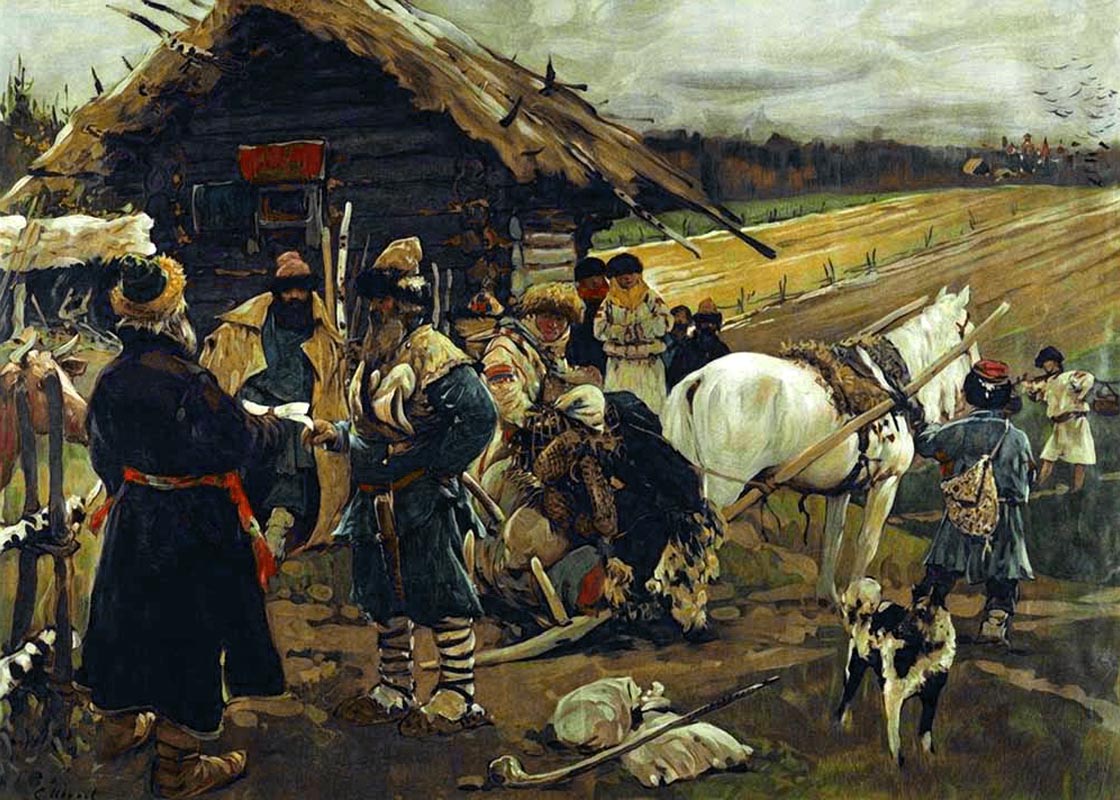
In 1597 a new law was enacted with would have a drastic effect on the lives of peasants in Russia. Serfdom had existed in a certain form since the very origins of Kievan Rus. During the reign of Ivan III, peasants were able to move to a new master around Yuriev Day (a feast-day of St George celebrated in autumn after the harvest had been collected). Ivan the Terrible later introduced temporary measures known as forbidden years when no movement was permitted. However the new law of 1597 completely removed the right for peasants to transfer to new masters around Yuriev Day, thereby making the peasants serfs, tied to the land and for all intents and purpose property of their master. Should a serf escape, the master had up to five years to find him and bring him back. Many of those that did attempt a runaway headed south or east to join the Cossacks.
The Election of Boris Godunov

In 1598 Tsar Feodor I, the last living descendent of Ivan the Terrible, died without issue, marking the end of the Moscow branch of the House of Ryurik. All other male members had previously been eliminated by either Ivan the Terrible or his mother. Russia found itself in the unprecedented situation of being without a leader. The search for a new tsar began and of course Boris Godunov, who had proved himself while serving as regent, seemed the logical choice. The Zemsky Sobor met and duly elected Boris Godunov as the new tsar, becoming the first Russian ruler not from the House of Ryurik which had ruled Rus since 862. To strengthen his hold on the throne Boris exiled several representatives of noble families, including the Shuisky, Golitsyn and the Romanov families, to monasteries in the far north of Russia.


